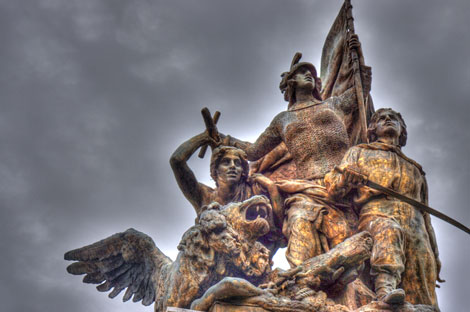A serial journal of cogent reflections and irreverent insights on the social effects of capitalism and the roots of partisan politics. Pairing prose with HDR photography and “flash points” drawn from current and historical perspectives, the author seeks to recover lost wisdom and courageous action beyond the shouting and noise of today’s headlines.
Chapter Twelve
Occupy Wall Street
Time Range: September 17, 2011
“[T]he American working class had accumulated a level of debt that was unsustainable. People could not make payments. They were exhausted: exhausted financially, exhausted physically by all the work, and exhausted psychologically because the family had been torn apart by everyone working.”
~ Richard Wolff, interview in The Sun, February 2012

“I have a feeling that right now, this human experiment on planet Earth is hitting the wall!”
~ Kalle Lasn, Estonian-born former adman lamenting the environmental and psychological costs of modern capitalism. He suggested in his magazine, Adbusters, that a September 17 occupation of Wall Street might be a good idea.

Some ideas just seem to catch on. The Occupy Wall Street movement began more as a sentiment than a plan, but that didn’t inhibit the national media from holding its collective breath waiting for demands. Somehow income inequality, the increasing concentration of wealth, and the effects of problematic externalities fostered by corporate persons never rose to the threshold of news. Certainly an annual piece on rising CEO pay or some poor neighborhood protesting corporate pollution might appear in newspapers, but these things were isolated from any larger context. Suddenly, and with just a slight reframing, Occupy Wall Street was rebranding our economic institutions as unjust, especially financial and insurance companies seemingly impervious to the havoc they helped wreak.
I imagine some of the financial analysts and brokers heading to work on September 17th wondered who these troublemakers were. Couldn’t this protest just be a new bunch of whiners and complainers, as if the ghosts of the Red Lion Pub had decided to go outside for a picnic? Yet the movement’s slogan, “We are the 99%” had a certain ring to it.

FDR spoke of not being content if “one-third or one-fifth or one-tenth — is ill-fed, ill-clothed, ill-housed, and insecure.” Fifty years prior, the journalist Jacob Riis illustrated with photographs “how the other half lives”; and some 20 years after FDR’s warning, Michael Harrington pointed out that poverty constituted an “other half” that was becoming increasingly invisible. Obviously, one-tenth, one fifth, one-third, or even one-half is not a tipping point.
Academics, economists, and politicians all missed an obvious marketing point of view. If being identified with the “other half” is unpleasant and to be avoided, who really wants to be associated with it, other than the poor, who don’t have a choice, or philanthropists, humanitarians, or social/political climbers who make it their business. Everyone else wants to be identified with the middle class or the well off.
The language of 99% cleverly shifted the perception of two halves and brought together a majority theoretically inclusive of nearly everyone. Occupy Wall Street was a counter-movement to its sociological twin, the Tea Party, which championed reducing the nation’s deficit and getting government out of the picture almost entirely. Occupy Wall Street championed addressing wealth distribution and the undue influence of corporations.
The Occupy Wall Street movement, which included spontaneous activities and protests in hundreds of cities around the world, accomplished something rarely seen after fruitless decades of discussing poverty, welfare, and safety nets. The taboo against talking about wealth distribution and capitalism had, for a brief moment, been lifted.
FLASH POINT
How American Corporations Transformed from Producers to Predators
“In 2010, the top 500 U.S. corporations — the Fortune 500 — generated $10.7 trillion in sales, reaped a whopping $702 billion in profits, and employed 24.9 million people around the globe. Historically, when these corporations have invested in the productive capabilities of their American employees, we’ve had lots of well-paid and stable jobs.
That was the case a half century ago.
Unfortunately, it’s not the case today. For the past three decades, top executives have been rewarding themselves with mega-million-dollar compensation packages while American workers have suffered an unrelenting disappearance of middle-class jobs. Since the 1990s, this hollowing out of the middle class has even affected people with lots of education and work experience. As the Occupy Wall Street movement has recognized, concentration of income and wealth of the top ‘1 percent’ leaves the rest of us high and dry.”
~ William Lazonick, The Huffington Post, April 3, 2012
Next Week: Chapter Thirteen: My Own Little Tea Party
If I had 400 people come over my house for tea and they happened to be the wealthiest 400 people in the United States, their accumulated wealth would be equal to the wealth of the bottom half of the entire US population, or approximately 150 million people. This would be true with or without my personal financial assets included. How did so few come to have so much, and conversely, how did so many come to have so little? Disparity in wealth has grown rapidly in the United States over the past half-century. What are some of the factors? Wouldn’t it be fun for my guests to discuss this?




0 Comments